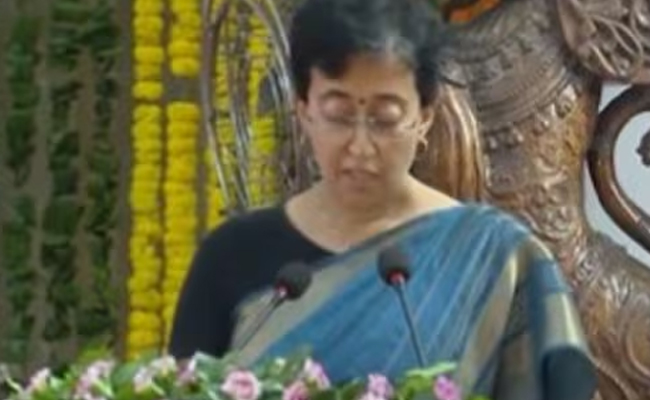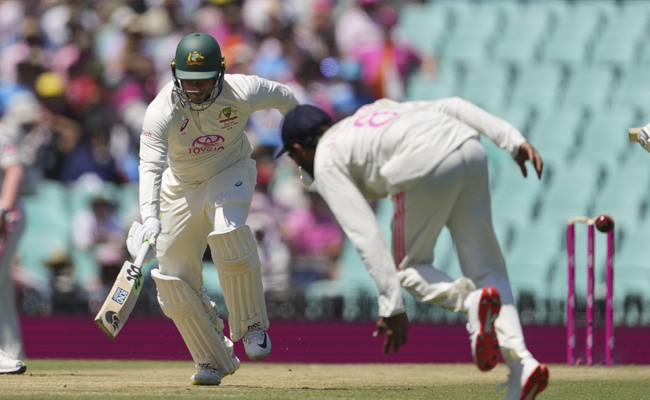New Delhi (PTI): Senior AAP leader Atishi was administered oath as the eighth Chief Minister of Delhi by Lieutenant Governor V K Saxena on Saturday.
Saxena administered the oath of office and secrecy to Atishi. She was chosen as the leader of the legislature party earlier this week, after her predecessor Arvind Kejriwal decided to resign.
Senior AAP leaders Kejriwal and Manish Sisodia were also present at the swearing-in event.
Atishi is Delhi's third woman chief minister after Congress' Sheila Dikshit and BJP's Sushma Swaraj.
She also becomes the 17th woman to hold the post of chief minister in independent India.
Atishi, however, will have a brief tenure in office as assembly elections in the national capital are due in February.
Let the Truth be known. If you read VB and like VB, please be a VB Supporter and Help us deliver the Truth to one and all.
Sydney (PTI): An out-of-sorts India was knocked out of the World Test Championship final as Australia cruised to a six-wicket victory in the fifth Test here on Sunday to reclaim the Border-Gavaskar Trophy after 10 years, leaving the visitors with several points to ponder in a difficult transition phase.
Australia won the five-match series 3-1 and also qualified for the World Test Championship final against South Africa slated at the Lord's from June 11 to 15.
A target of 162 could have been trickier had new Test captain Jasprit Bumrah been in a position to bowl despite painful back spasms but once Virat Kohli led the team out, it was as clear as the Sydney skyline that defending the total would be next to impossible.
Bumrah deservedly claimed the player of the series honour for his astonishing haul of 32 wickets in five matches but that was hardly a consolation for the shambolic team performance that India managed.
"Little frustrating but sometimes you have to respect your body, you can't fight your body. Disappointing, probably missed out on the spiciest wicket of the series," Bumrah said of his inability to bowl in the second innings during the post-match presentation ceremony.
Prasidh Krishna (3/65 in 12 overs) and Mohammed Siraj (1/69 in 12 overs) were not a patch on Bumrah and despite multiple breakthroughs, they bowled too many poor deliveries to make it easy for the hosts to canter home in just 27 overs.
Usman Khawaja (41), Travis Head (34 not out) and debutant Beau Webster (39 not out) completed the formalities, putting an end to India's misery in a tour that has exposed all of the team's batting frailties and an unhealthy reliance on Bumrah.
Once Bumrah was ruled out after he tried some shadow bowling during the morning warm-up session and didn't feel comfortable, the writing was on the wall.
The magnificent Scott Boland (6/45) and the ever-reliable Pat Cummins (3/44) polished off the Indian tail for just 157 in 39.5 overs. If one takes out Rishabh Pant's fiesty 61 and Yashasvi Jaiswal's 22, the other nine players collectively contributed a mere 74 runs.
The series would leave the men who matter in Indian cricket establishment with a lot on their minds when they deliberate on ways to get the house back in order.
With six of the completed innings yielding less than 200 runs, one doesn't need a soothsayer to tell what went wrong on the tour.
Regular skipper Rohit Sharma and batting talisman Virat Kohli flopped with technical issues troubling them throughout the season.
Jaiswal (391 runs) was the top-scorer despite three ducks followed by rookie Nitish Kumar Reddy (298 runs), KL Rahul (276 runs) and Pant (255 runs).
As much as one wants to take a nuanced view of Rohit and Kohli's poor form but it is undeniable that both veterans are finding it increasingly difficult to stem the rot that has set in their batting.
There are a few good youngsters in the fringes and the new World Test Championship cycle would demand that they be given a chance to develop over time.
While a tough call on Kohli and Rohit is awaited, the BCCI brass also needs to seriously look at whether coach Gautam Gambhir is the right man to be in-charge across formats.
Under Gambhir, India have lost six Tests out of 10 during the season going by apart from being defeated in an ODI series in Sri Lanka.
If Kohli and Rohit are held accountable, Gambhir can't be let off merely because the team is in transition.
The head coach's head-strong approach is an pen secret and it is not earning him too many friends in the dressing room.
Ravichandran Ashwin's retirement after Brisbane and Rohit's eventual call to drop himself happened in a manner that can best be described as abrupt.
Messing with a player's gameplan isn't the best way to manage as Rishabh Pant demonstrated by oscillating between too careful at times that only disrupted his natural rhythm.
But more than batting, it would be the bowling – both pace and spin that would be a huge concern for the national selection committee as well as the team management.
Bumrah's absence showed what India missed on the final day even though it was heavily tilted towards Australia.
As Glenn McGrath put it, had Bumrah not taken 32 wickets, there was no chance that India would have managed a 1-3 margin.
In Brisbane, they were saved by rain and in Melbourne, Rohit let the game drift away during the final session on day four.
It has taken Mohammed Siraj 36 Test matches to complete 100 wickets and these are not exactly great figures.
Akash Deep is still raw but has potential while Prasidh Krishna can swing between bowling unplayable deliveries and pedestrian work.
Harshit Rana is simply not prepared for this level and would need to play loads of Ranji Trophy, Duleep Trophy and India A games to get ready for big Tests.
In the spin department, Ravindra Jadeja is now more of a batter and less of a spinner unless the wicket has something to offer from day one like it happens in India.
Washington Sundar's 12 wickets in Pune should be looked in isolation and he is also more of a batter than a competent off-spinner on batting-friendly wickets.
Only silver lining of the series is Jaiswal taking over the mantle as the next batting superstar and the raw talent exhibited by Nitish Reddy.
Reddy's bowling, if it develops, would give India a chance to play three spinners at home on decent tracks.





